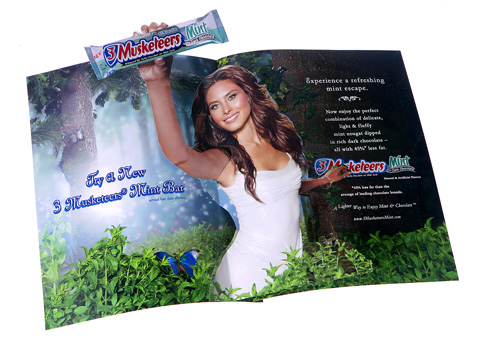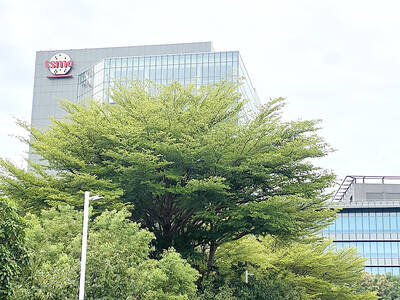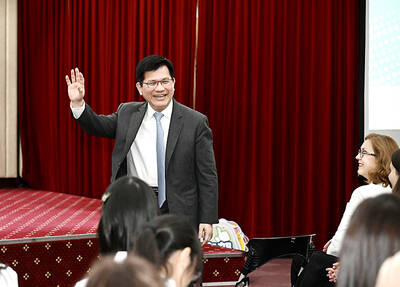Readers of the latest issue of People magazine may have been startled to open to a bulky page in the middle and hear Natasha Bedingfield’s latest pop song start playing out loud. It was courtesy of a large ad for Verizon Wireless’ music download service — and a tiny battery and speaker wedged within the pages of the magazine.
Or perhaps readers have gotten used to such sensory affronts from their reading material. With blinking lights, pop-up ads, kiss-on lipstick samples, scratch-off scents, melt-in-your-mouth taste strips and even pocket squares, advertisers are stuffing magazines full of just about anything to make their advertisements stand out.
One reason for the phenomenon is the technology that makes it less expensive to put unusual objects in magazines and that helps advertisers create more sophisticated inserts. Improvements, for example, in hiding fragrance samples under peel-off strips have also reduced the backlash from people with allergies.

PHOTO: NY TIMES NEWS SERVICE
But there is another dynamic at work: With so much of the publishing industry shifting to the Web, magazine executives are trying to use their print products as a tactical advantage.
Not only are they reminding advertisers that magazines are good places to attach things, but they are also seeking out and conceiving these projects.
“For us, it’s be clever or die,” said Peter King Hunsinger, the publisher of GQ, which tucked fabric pockets into 19,000 April issues for a Lexus promotion.
And advertisers are looking for concrete returns on these creative ads, many of which use coupons or other incentives to drive consumers to Web sites or stores, where the effectiveness of the ad can be measured.
“The days of just trying to be creative and doing these without a serious commitment to marketing results are gone,” said Mike Maguire, the chief executive of Structural Graphics, a company that produces three-dimensional ads, like pop-up panties for a Fruit of the Loom advertisement and a vertical fin for Discovery Channel’s Shark Week.
Advertisers have been trying to stand out from the pack since the perfume strip was invented in 1979, when the scent was so strong that “you could kind of smell it before you even opened the magazine,” recalled Diane Crecca, vice president for sales, marketing and business development at Arcade Marketing, which invented the scent strip.
The technology for shampoos or lotions was not much better.
“They would sometimes burst inside the magazine,” said Agnes Landau, senior vice president for global makeup marketing at Clinique. “There was a little bit of a backlash from the customers at that point because they didn’t want the magazine being damaged.”
Advertisers were also unhappy because the samples they sent out were subject to an extra fee from the post office. Arcade Marketing executives studied what the post office’s definition of “sample” was. By 1997, it had devised a thumb-size packet that could withstand pressure without bursting and the packet was small enough to avoid the excess fee.
More technology advances on the chemical side, such as being able to affix face powder to a piece of paper, led to powder, lipstick and even nail-polish samples. Perfume samples now can be contained beneath seals and wrapped in little packages, a relief to allergy sufferers.
“We hope to see more of it,” said Angel Waldron, spokeswoman for the Asthma and Allergy Foundation of America.
“The biggest issue for editors and, of course, publishers, is how many there are,” said John Fennell, associate professor of magazine journalism and holder of the Meredith Chair in service journalism at the University of Missouri School of Journalism.
“They break up the editorial in the book — you’re paging through the book and you have big, stiff cardboard things in the middle,” Fennell said. “So as much as they make money, there’s a sense of how many can be put in the book without there being an overload?”

FIREPOWER: On top of the torpedoes, the military would procure Kestrel II anti-tank weapons systems to replace aging license-produced M72 LAW launchers Taiwan is to receive US-made Mark 48 torpedoes and training simulators over the next three years, following delays that hampered the navy’s operational readiness, the Ministry of National Defense’s latest budget proposal showed. The navy next year would acquire four training simulator systems for the torpedoes and take receipt of 14 torpedoes in 2027 and 10 torpedoes in 2028, the ministry said in its budget for the next fiscal year. The torpedoes would almost certainly be utilized in the navy’s two upgraded Chien Lung-class submarines and the indigenously developed Hai Kun, should the attack sub successfully reach operational status. US President Donald Trump

Taiwan Semiconductor Manufacturing Co (TSMC, 台積電) is expected to start construction of its 1.4-nanometer chip manufacturing facilities at the Central Taiwan Science Park (CTSP, 中部科學園區) as early as October, the Chinese-language Liberty Times (the Taipei Times’ sister newspaper) reported yesterday, citing the park administration. TSMC acquired land for the second phase of the park’s expansion in Taichung in June. Large cement, construction and facility engineering companies in central Taiwan have reportedly been receiving bids for TSMC-related projects, the report said. Supply-chain firms estimated that the business opportunities for engineering, equipment and materials supply, and back-end packaging and testing could reach as high as

ALL QUIET: The Philippine foreign secretary told senators she would not respond to questions about whether Lin Chia-lung was in the country The Ministry of Foreign Affairs on Wednesday confirmed that a business delegation is visiting the Philippines, but declined to say whether Minister of Foreign Affairs Lin Chia-lung (林佳龍) is part of the group, as Philippine lawmakers raised questions over Lin’s reported visit. The group is being led by Deputy Minister of Agriculture Huang Chao-chin (黃昭欽), Chinese International Economic Cooperation Association (CIECA) chairman Joseph Lyu (呂桔誠) and US-Taiwan Business Council (USTBC) vice president Lotta Danielsson, the ministry said in a statement. However, sources speaking on condition of anonymity said that Lin is leading the delegation of 70 people. Filinvest New Clark City Innovation Park

DEFENSIVE EDGE: The liaison officer would work with Taiwan on drones and military applications for other civilian-developed technologies, a source said A Pentagon unit tasked with facilitating the US military’s adoption of new technology is soon to deploy officials to dozens of friendly nations, including Taiwan, the Financial Times reported yesterday. The US Department of Defense’s Defense Innovation Unit (DIU) is to send a representative to collaborate with Taiwan on drones and military applications from the semiconductor industry by the end of the year, the British daily reported, citing three sources familiar with the matter. “Drones will certainly be a focus, but they will also be looking at connecting to the broader civilian and dual-use ecosystem, including the tech sector,” one source was